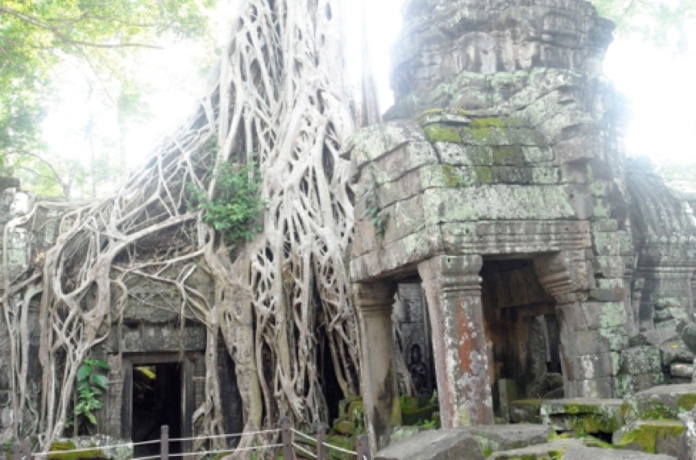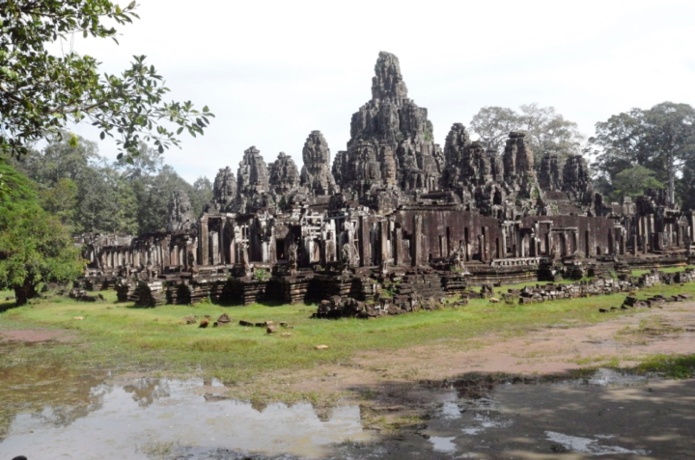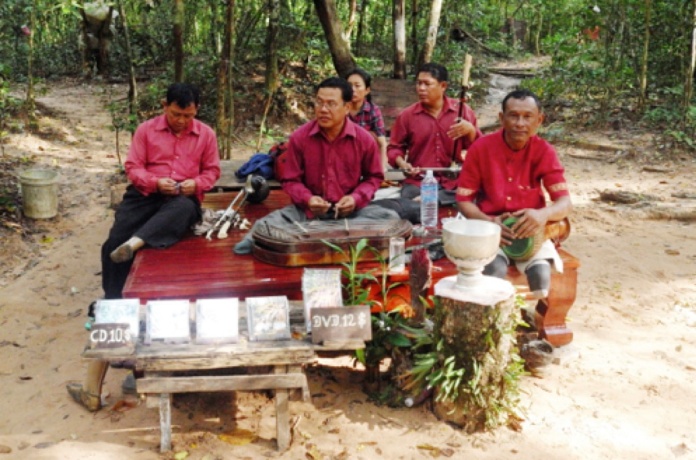This morning we visited two sites constructed by the last great Khmer monarch, Jayavarman VII (1125-1218 c. e.), the Ta Prom and the Bayon. Jayavarman departed from the Shaivite faith of his predecessors and adopted Buddhism, so both sites resonate with Buddhist iconography (although a Hindu reaction after his death led to the destruction or effacement of many sculptures and carvings). Ta Prom is a monastery dedicated to Jayavarman’s mother. The name (a later adoption) combines words for “grandmother” and “Brahma” in reference to the four-faced stupas (reliquaries) that dot the compound. Here is the small causeway that leads to the site:
Ta Prom’s special charm comes from the many large trees that have spring up from roofs and the scattered stones, lending the site a romantic and haunting air. Apparently, “Tomb Raiders” with Angelina Jolie was filmed here. Our guide, Sam, took pleasure in pointing out specific places where scenes were shot.
Sam is a story unto himself.
During our rides from site to site he told us about his life. As a sixteen-year old high school student in 1975, he and his entire family were ordered by the Khmer Rouge (Cambodian communists) out of Siem Reap to their natal village seventy kilometers into the countryside. Because the family was judged to be “middle class,” his father and older bother were soon shot. Although all high school students 10th grade and above were slated for liquidation, Sam, a tenth grader, somehow survived. He spent much of the next three and a half years of Khmer Rouge rule working in rice and cane fields. Workers had two scant meals a day. At one point, he was so hungry that he ate a fruit known to be toxic, a decision he survived with a bad headache and “fuller stomach.” A single mistake in handling the crops could lead to a visit by several “friendly” people from the regime. That would be the end. One of his friends accidentally cut down a small cane plant while removing weeds, and was so visited. The visitors said that they needed him for help on a project elsewhere but that he shouldn’t take his things because “he would be back that night.” The friend was never seen again. Many of the two million Cambodians who died (out of a population of eight million) disappeared in this way: a plant being worth more than a human being. At one point, in order to avoid being conspicuous as a student, Sam dyed his white school shirt black using the leaves of a toxic tree (he pointed these leaves out to us floating in the moat at Ta Prom). The ploy must have worked, although the toxin made Sam’s back itch whenever he he sweated heavily.
Our next stop was Angkor Thom and the Bayon, Jayavarman’s amazing tomb complex with dozens of four faced reliquaries, including a central one dedicated to the king himself. Researchers believe that many of these faces are of deceased members of Jayavarman’s retinue (120 name inscriptions have been found), although they also resemble the bodhisattva Avalokiteshvara. Once again, as I said in my lecture, we see a royal mausoleum that honors the dead king while linking him back to sacred events, in this case a Buddha-to-be and evocations of the four-faced creator God Brahma.
Here is the Bayon from the front:
And here are two of the reliquaries, with their four-faced ancestors and/or images of the bodhisattva Avalokiteshvara:
Our visit ended with an elephant ride around the whole site. Here, some fellow travelers wobbling ahead of us on their elephant.
Finally, a parting image of the Bayon:
On the way back to the hotel, Sam told us of his years as a fighter on the Vietnamese side against the Khmer Rouge during Cambodia’s civil war, which lasted from 1979 until 1998. He also served during this period as a schoolteacher and school principal. Going to work, he carried an AK47 and took out some revenge on Khmer Rouge opponents for the murder of his father and brother. He was also very careful to keep an eye out for the Khmer Rouge landmines, small green plastic devices only big enough to blow one’s foot off, which Khmer Rouge insurgents routinely uses to protect themselves from pursuit. Here is a small musical band made up of landmine victims that set up shop on the pathway out of the Bayon.
By the way, Sam married a schoolmate with whom he worked during the Khmer Rouge years. He now has four children and six grandchildren. He’s a survivor.










Totally enjoyed reliving the experience through your descriptive words and lovely pictures. It was a great trip for sure.